Exploring Popular Chinese Dishes: What Can I Eat in China?
China is a vast country with a rich culinary heritage, and when you visit, you’ll discover a wide array of delicious dishes. Whether you’re a fan of spicy, savory, or sweet foods, Chinese cuisine has something for everyone. Let’s explore some popular dishes you can try while in China.
Staple Dishes
When it comes to staple foods, rice and noodles are the main players in Chinese cuisine. Here are a few dishes to consider:
- Fried Rice (炒饭): A popular dish made with leftover rice stir-fried with vegetables, meat, and soy sauce.
- Noodles (面条): There are many types of noodles, including wheat and rice varieties. Dishes like Dan Dan Noodles and Chao Mian (stir-fried noodles) are must-tries.
- Dumplings (饺子): These can be steamed or boiled and are often filled with meat and vegetables. They are an iconic part of Chinese cuisine.
Regional Specialties
Chinese cuisine varies greatly by region, each having its own unique flavors and cooking styles. Here are some popular regional dishes:
Sichuan Cuisine
- Mapo Tofu: This spicy dish features tofu in a rich sauce made with ground pork and Sichuan peppercorns, creating a tingly sensation.
- Kung Pao Chicken: A combination of diced chicken, peanuts, and vegetables stir-fried in a spicy sauce.
Cantonese Cuisine
- Dimsum: A style of Cantonese cuisine that includes a variety of small dishes served in steamer baskets or on small plates. You can enjoy dumplings, buns, and more.
- Cantonese Roast Duck: Known for its crispy skin and tender meat, this dish is beloved for its savory flavors.
Beijing Cuisine
- Peking Duck: A famous dish noted for its crispy skin, served with thin pancakes and hoisin sauce.
- Zhajiangmian: Noodles topped with a savory bean paste, often accompanied by fresh vegetables.
Vegetarian and Vegan Options
If you’re vegetarian or vegan, China has plenty to offer. Many traditional dishes can be adapted to suit your dietary needs. For example:
- Vegetable Stir-fry: Freshly cooked vegetables sautéed with garlic and soy sauce.
- Tofu Dishes: Tofu is a staple in many Chinese meals, either fried, steamed, or braised.
Street Food
Street food is an essential part of the Chinese culinary experience. Sampling local street food allows you to taste authentic flavors. Here are some popular street food items:
- Jianbing: A savory crepe filled with egg, scallions, and various fillings, making for a delicious breakfast option.
- Stinky Tofu: Fermented tofu that’s deep-fried, a unique flavor experience that many locals love.
- Grilled Skewers: Small skewers of meat and vegetables seasoned and grilled to perfection.
Popular Beverage Pairings
Enhance your dining experience by pairing your meal with traditional drinks:
- Chinese Tea: Enjoy varieties like Oolong, Pu-erh, or Jasmine to complement your meal.
- Baijiu: A strong Chinese liquor that goes well with hearty dishes.
Tips for Choosing Food in China
Eating in China can be both exciting and challenging. Here are some tips to ensure you enjoy the experience:
- Try local specialties instead of seeking familiar Western dishes.
- Don’t hesitate to ask locals for recommendations.
- Be adventurous—don’t shy away from trying new dishes!
With its diverse and flavorful options, you are sure to have a memorable culinary journey in China. Whether you stick to rice and noodles or explore regional specialties, there is always something delicious waiting for you.
To learn more about Chinese cuisine, consider visiting China Highlights or Chowhound for additional resources and guidance.
Regional Variations in Chinese Cuisine
Chinese cuisine is a vibrant tapestry woven from a myriad of regional flavors and cooking styles. Each area of China boasts its unique ingredients, culinary techniques, and signature dishes, making the exploration of Chinese food an adventure for any palate. Understanding these regional variations allows you to experience the full spectrum of flavors that this rich cuisine has to offer.
North China
In Northern China, wheat-based products dominate the culinary scene. The use of dumplings, noodles, and steamed buns is prevalent, thanks to the cooler climate that favors wheat cultivation. Some popular dishes from this region include:
- Jiaozi (Dumplings): Often stuffed with minced pork, vegetables, or shrimp.
- Lamian (Hand-pulled Noodles): A dish that highlights skillful noodle-making.
- Peking Duck: A famous dish known for its crispy skin and rich flavor.
Don’t miss out on local specialties such as Beijing hot pot, which is perfect for sharing and enjoying with friends and family.
South China
The southern regions, particularly Guangdong (Canton), are famous for their dim sum, a style of serving small dishes of food, perfect for brunch or lunch. South China emphasizes fresh ingredients and lighter seasoning to let the natural flavors shine. Here are some highlights:
- Dim Sum: A variety of small dishes served with tea, ranging from dumplings to pastries.
- Char Siu (BBQ Pork): Tender, flavorful pork marinated in a sweet sauce.
- White Cut Chicken: A simple yet flavorful dish served with a dipping sauce.
Another regional favorite is the Cantonese seafood, which features fish and shellfish prepared with delicate sauces and herbs.
East China
East China’s Jiangsu and Zhejiang provinces are known for their sweet and savory flavors, often featuring fresh bamboo shoots and river fish. The dishes are beautifully presented and often emphasize balance in taste. Key dishes include:
- Suangy Pork: A sweet braised pork dish that melts in your mouth.
- Wuxi Spare Ribs: Tender ribs cooked in a sweet soy sauce.
- Beggar’s Chicken: Chicken wrapped in lotus leaves and clay, baked to perfection.
Local marvels can include visits to cities like Hangzhou, where you can enjoy the famous West Lake fish.
West China
In stark contrast, the cuisine of West China, particularly Sichuan, is known for its bold and spicy flavors. Sichuan peppercorn adds heat and a unique numbing sensation. Dishes to try include:
- Mapo Tofu: Spicy tofu dish cooked with minced meat and chili bean sauce.
- Kung Pao Chicken: Stir-fried chicken with peanuts, vegetables, and chili peppers.
- Sichuan Hot Pot: A communal meal with a spicy broth perfect for cooking various meats and veggies.
If you are adventurous, explore the mysterious flavors of Tibetan cuisine found in the western regions as well.
Central China
Central China, particularly Hunan, is famous for its spicy and sour dishes, influenced by local ingredients and the mountainous terrain. Some must-try dishes include:
- Hunan Pork with Chili: Stir-fried pork with a generous amount of chili peppers.
- Steamed Fish Head with Diced Hot Red Peppers: A local specialty that is rich in flavor.
- Sour Fish Soup: A unique blend of sourness and heat.
The diversity in spices and herbs used here creates a culinary experience that leaves a lasting impression.
A Diverse Culinary Experience
Whether you are sampling street food in the bustling markets or dining in a fine restaurant, China’s regional cuisines offer an exquisite culinary journey. Each dish tells a story, reflecting the heritage, ingredients, and traditions of the area it comes from. To explore more about provincial specialties, consider visiting sites like Fodor’s Travel for insights on where to eat.
As you find your way through the rich landscape of Chinese cuisine, remember to embrace the diversity. Trying dishes from different regions will not only satiate your hunger but also deepen your appreciation for this global culinary treasure.
Street Food Adventures: Must-Try Dishes in China’s Urban Centers
When you think of travel, food often plays a central role in the experience. In China, street food offers a unique glimpse into the heart of its vibrant culture and daily life. The urban centers such as Beijing, Shanghai, and Chengdu are bursting with flavors and aromas that thrill the senses. Let’s explore some must-try street food dishes that will make your mouth water and your adventure unforgettable.
First on your list should be *Jianbing* (煎饼), a beloved Chinese breakfast item. This savory pancake, made from a batter of wheat and mung bean flour, is cooked on a hot griddle and filled with egg, pickled vegetables, green onions, and often a crispy cracker for texture. Not only is Jianbing delicious, but it’s also fast and portable, making it perfect for a quick bite on the go.
In Shanghai, you can’t miss *xiaolongbao* (小笼包). These steamed soup dumplings are a culinary highlight. Each dumpling is filled with a mixture of pork and hot soup, creating a burst of flavor when you take a bite. Careful handling is key—bite a small hole to let the steam escape before indulging in the whole dumpling!
Another street food sensation is *baozi* (包子), steamed buns filled with various ingredients. They can be sweet or savory, but the most popular are usually filled with marinated pork or vegetables. You can find baozi vendors on nearly any street, and they’re an incredibly satisfying snack or meal.
For the adventurous eater, try *stinky tofu* (臭豆腐), a fermented tofu dish with a strong odor that might be off-putting at first. This local delicacy is crispy on the outside and soft on the inside, often served with pickled cabbage. It’s a dish that many swear by once they get past the initial smell. Don’t be afraid to dive in—stinky tofu packs a flavorful punch!
If you’re in Sichuan, make sure to try the spicy *mapo tofu* (麻辣豆腐). This dish consists of silken tofu set in a spicy sauce containing chili bean paste, and it’s often topped with ground pork. While this isn’t a street food you’d see on every corner, many street vendors offer their own delicious interpretations, making it a dish worth seeking out.
As night falls, head to your local night market for an eclectic mix of treats. One popular choice is *chuan* (串), or skewers of grilled meat, often seasoned with a blend of spices. You can find everything from skewered lamb to juicy chicken, barbecued right in front of you. Each bite is a burst of smoky flavor that makes for an excellent late-night snack.
Must-Try Street Food List:
- Jianbing (煎饼): Savory pancake filled with egg and vegetables.
- Xiaolongbao (小笼包): Steamed soup dumplings with pork.
- Baozi (包子): Steamed buns filled with various sweet or savory ingredients.
- Stinky Tofu (臭豆腐): Fermented tofu, crispy outside and soft inside.
- Mapo Tofu (麻辣豆腐): Spicy tofu dish often found at night markets.
- Chuan (串): Barbecued skewers of meat seasoned with spices.
Another favorite you should try is *scallion pancakes* (葱油饼). These deep-fried, flaky pancakes are made with dough and layered with chopped scallions. They are crispy on the outside and soft inside, delivering a delightful crunch with each bite. Street vendors often serve them fresh off the griddle, making them a tasty and filling snack.
As you navigate the bustling streets and vibrant markets, keep an eye out for sweet treats too. *Tanghulu* (糖葫芦), skewered candied fruit, can be a fun end to your food adventure. Typically made with hawthorn berries, these sweet bites are coated in a hard candy shell. They are not only delicious but also visually appealing, making them perfect for Instagram-worthy moments.
When exploring street food in China, don’t hesitate to engage with vendors and ask about their specialties. Street food is not just about eating; it’s about connecting with local culture. Each dish tells a story, revealing the region’s traditions and flavors.
For more insights into the vibrant Chinese street food culture, visit China Highlights or explore The Beijinger for local dining recommendations. Each culinary journey is unique, so get ready to take in the sights, sounds, and flavors of China’s urban streets.
Vegetarian and Vegan Options in Chinese Food
When exploring Chinese cuisine, it’s a delight to discover the range of vegetarian and vegan options available. The diversity of flavors and ingredients allows for creative and nutritious meals that can satisfy both dietary preferences. Here’s what you can enjoy while dining in China if you’re looking for plant-based choices.
Chinese food is rich in vegetables, grains, and tofu, making it a great choice for vegetarians and vegans. Here are some popular dishes and ingredients that you might want to try:
- Vegetable Fried Rice – Stir-fried rice with fresh vegetables and seasonings. Make sure to ask for no egg for a vegan version.
- Ma Po Tofu – A popular Sichuan dish with tofu and spicy bean sauce. Choose a version without meat.
- Chop Suey – This dish often includes a variety of vegetables and can be made vegan by excluding meat and egg.
- Veggie Spring Rolls – These crispy delights are often filled with cabbage, carrots, and bean sprouts. Ensure they use a soy-based sauce for dipping.
- Kung Pao Tofu – A vegetarian take on the classic kung pao chicken, substituting tofu while retaining the spicy and nutty flavors.
In addition to these dishes, here are some key ingredients to look out for when ordering:
- Tofu – A versatile protein source rich in flavor and texture, used in many traditional Chinese dishes.
- Seitan – Sometimes known as wheat meat, it’s a protein-rich alternative that mimics the texture of meat.
- Tempeh – Fermented soybeans that offer a nutty flavor and can be used in various stir-fries.
- Vegetables – Look for options like bok choy, broccoli, bell peppers, and mushrooms, commonly featured in many recipes.
When eating in China, don’t hesitate to express your dietary needs clearly. Here are some phrases that might help:
- 无肉 (wú ròu) – No meat.
- 我吃素 (wǒ chī sù) – I am vegetarian.
- 我不吃鸡蛋 (wǒ bù chī jī dàn) – I don’t eat eggs.
- 请不要放肉 (qǐng bù yào fàng ròu) – Please do not add meat.
While many traditional dishes may contain meat or seafood, Chinese cuisine is quite adaptable. Additionally, visiting local vegetarian restaurants can unveil enticing options. Some cities have restaurants dedicated exclusively to vegetarian or vegan dishes, often utilizing ingredients like mushrooms, nuts, and grains to recreate familiar flavors in a plant-based manner. In China, look for locations such as:
- Hanbao Mei – A chain known for vegetarian burgers and more.
- Vege Planet – Offering a wide variety of veg-friendly dishes.
- Green Common – Focused on plant-based eating with innovative options.
Furthermore, if you are in bigger cities like Beijing or Shanghai, you might come across Buddhist vegetarian restaurants, which typically serve meals without animal products. These eateries emphasize fresh vegetables and spices, providing a unique dining experience.
It’s important to be aware of hidden ingredients. Some sauces or broths might contain meat stock or fish sauce, so always check with the staff. Opting for simple stir-fried vegetables or steamed dishes can minimize the risk of accidentally consuming animal products.
The key takeaway is to embrace the abundance of vegetarian and vegan choices available in Chinese cuisine. Whether indulging in a flavorful bowl of vegetable dumplings or crispy tofu stir-fry, there is a delicious array to explore. Enjoying Chinese food as a vegetarian or vegan can be a rewarding experience that satisfies your culinary curiosity and dietary preferences.
The Role of Rice and Noodles in Chinese Meals
When you think about Chinese meals, two staples often come to mind: rice and noodles. These two ingredients are integral to the culinary landscape in China and have unique roles in meals throughout the country. Understanding these roles can provide you with a richer experience when dining in China or even trying to replicate the flavors at home.
Rice is perhaps the most celebrated staple food in China. It is more than just a side dish; it is a fundamental part of many meals across various regions. In southern China, for example, rice is often the primary source of carbohydrates. It complements a variety of dishes, whether they are stir-fried vegetables, meats, or flavorful sauces. Not only does rice serve as a sustainer, but it also acts as a canvas for the other flavors on the plate.
Noodles, on the other hand, are equally important and come in many shapes, sizes, and types. They also have regional ties but are more common in northern China. Wheat-based noodles dominate this region and are typically served in soups, stir-fries, or as a standalone dish. This versatility makes noodles a popular choice among locals and tourists alike. Each type of noodle, from hand-pulled to rice noodles, boasts its own flavor and texture, providing an entirely different culinary experience.
The balance between rice and noodles can be seen in daily meals in China, which might incorporate both. This balance is often a reflection of cultural practices, where the choice between rice or noodles might come down to family preferences or regional traditions.
Here’s a little detail on how different regions prioritize these staples:
| Region | Primary Staple | Popular Dishes |
|---|---|---|
| Southern China | Rice | Congee, Fried Rice |
| Northern China | Noodles | Beef Noodle Soup, Cold Noodles |
| Eastern China | Both | Sweet and Sour Pork with Rice and Noodles |
| Western China | Noodles | Lan Zhou Beef Noodles, Stir-Fried Noodles |
Rice and noodles are prepared in various ways, and both options often include a medley of spices and ingredients that elevate the meal. For example, fried rice can be a simple yet delicious blend of day-old rice, vegetables, and protein, all stir-fried in a wok. In contrast, noodle dishes often come with rich broths and are highlighted by the mix of savory sauces and aromatic herbs. Each method of preparation draws out different flavors, textures, and aromas, making both rice and noodles feel like entirely different dishes based on how they are cooked.
When you dine in China, it’s common practice to order several dishes and enjoy a communal style of eating. In this dining format, rice or noodles often serve as the base of a meal, with various toppings and sides shared among friends or family. Offering both options on the table can cater to a range of preferences—those who prefer the heartiness of rice and those who enjoy the chewiness of noodles.
Exploring these culinary staples is a journey of taste. You can venture to local eateries, food markets, or well-known restaurants to experience these flavors firsthand. Whether it’s a bowl of comforting noodle soup or a plate of aromatic fried rice, the options are endless.
For more authentic recipes and insights into how rice and noodles are utilized in Chinese cooking, check out China Sichuan Food or The Beijinger. Both provide excellent resources for diving deeper into the methods and traditions behind Chinese cuisine, making it easier for you to recreate those flavors at home.
When visiting China, embrace the dish choices available to you. Whether you reach for a bowl of fried rice or a plate of hand-pulled noodles, each choice represents a special connection to the culture. Your dining experience will not only fill your stomach but also enrich your understanding of one of the world’s most diverse culinary heritages.
Traditional Chinese Dining Etiquette
Dining in China is not only about the food, but also about the traditions and manners surrounding meals. Understanding these customs can enhance your experience and show respect for the culture. When you find yourself at a table in China, here are some essential etiquette tips to keep in mind.
Understanding the Seating Arrangement
Seating during a meal is significant in Chinese culture. The host sits at the head of the table, usually facing the entrance. Guests and family members take their seats based on seniority or importance. If you’re invited, wait for your host to designate your seat. If you’re unsure, observe where others are sitting and follow their lead.
Proper Use of Utensils
Chinese dining typically involves using chopsticks, which can be a bit challenging for those unfamiliar. Here are some key points regarding chopstick etiquette:
- Never stick chopsticks vertically into a bowl of rice, as this resembles incense sticks used in funerals.
- Don’t use chopsticks to point or play with your food.
- When not in use, place your chopsticks on the provided holder, rather than on your plate.
Serving and Sharing Food
Sharing food is common in China. Meals are often served family-style, meaning dishes are placed in the center for everyone to take from. Here’s how to navigate this:
- Always serve others before serving yourself, especially to elders or your host.
- Use the serving utensils (usually provided) to take food from shared platters.
- Avoid finishing all the food from a dish; leaving a little behind is a sign of respect for the host’s generosity.
Respect for Elders and Guests
Respecting elders is a cornerstone of Chinese culture. When dining:
- Wait for elders to begin eating before you start.
- Lift your glass for a toast, but do so lower than the elder’s glass as a sign of respect.
Tea and Alcohol Etiquette
Tea is a common beverage during meals, and pouring tea is a ritual that showcases hospitality. Here’s how to handle tea and alcohol:
- When pouring tea, hold the teapot with both hands and pour for others first before serving yourself.
- If toasting with alcohol, the person being toasted should take a sip from their glass.
- It is polite to refill others’ drinks, but never let your glass be empty.
Handling Leftovers and Waste
While it’s essential to leave some food on your plate as a sign of satisfaction, there is an art to managing leftovers:
- If you can’t finish your meal, it may be appropriate to ask for a ‘doggy bag,’ but this is not common in traditional settings.
- In casual dining, it’s acceptable to leave some food on your plate. It shows the host that you had enough to eat.
Paying the Bill
Usually, the host pays for the meal, and guests should not insist on paying to honor the host’s invitation. However, if you’re invited to a meal multiple times, it is thoughtful to offer to pay for the next outing. When the bill arrives, it’s customary for everyone to try to pay, but the host should have the final say.
Dining Conversation
Conversations during meals should be light and pleasant. Avoid discussing heavy topics or controversial issues. Compliments about the food are always appreciated—feel free to express your enjoyment!
In learning about traditional dining etiquette in China, you’ll find that the experience can enrich your travels and interactions. For a deeper dive into Chinese culture and dining practices, visit China Highlights for a comprehensive guide and insights.
By understanding these customs, you can navigate a traditional meal with ease and respect. Enjoy every bite and the delightful exchanges that come with sharing a meal in China!
Unique Cooking Techniques in Chinese Food Preparation
Chinese cuisine is renowned for its diverse flavors, vibrant colors, and unique cooking techniques. Many of these techniques not only enhance the taste of the food but also contribute to the presentation and texture of each dish. Here’s a look at some notable cooking methods that make Chinese food distinct and delectable.
Stir-Frying
Stir-frying is perhaps the most recognizable technique in Chinese cooking. This method involves cooking food quickly at high heat in a wok with a small amount of oil. The quick cooking duration helps in retaining the nutrients and vibrant colors of vegetables while ensuring that meat remains tender and flavorful.
- Wok: The key to effective stir-frying is using a well-seasoned wok, which allows for even heat distribution.
- Ingredients: Food is typically cut into uniform pieces to ensure even cooking.
Steaming
Steaming is a method often used for preparing fish, dumplings, and vegetables. This technique retains the natural flavors and nutrients without the addition of oil. In China, steaming is often done in bamboo steamers, which not only serves a functional purpose but also infuses food with a subtle aroma.
- Health Benefits: Food retains its moisture and nutrients, making it a healthy cooking option.
- Dumplings: The most famous steamed dishes include Xiao Long Bao (soup dumplings) and Jiaozi (potstickers).
Braising
Braising combines both cooking methods: browning the food first and then slow-cooking it in a small amount of liquid. This approach allows flavors to meld beautifully. It is commonly used for meat dishes, where tough cuts become tender and infused with a rich sauce.
- Flavor Infusion: The long cooking time allows spices and aromatics to deeply penetrate the meat.
- Famous Dishes: Red-cooked pork (Hong Shao Rou) and chicken braised in soy sauce are popular examples.
Deep-Frying
Deep-frying is essential to many beloved Chinese snacks. Items like spring rolls and crispy fried chicken showcase the delightful crunch that this technique provides. It involves submerging food in hot oil until golden brown. This method adds a satisfying texture and flavor contrast.
- Technique: Ingredients are often coated in batter or flour to create a crispy outer layer.
- Popular Dishes: Wontons and shrimp toast are among the well-loved deep-fried dishes in Chinese cuisine.
Roasting
Roasting is used for various meats and provides a smoky flavor profile. It’s particularly famed in dishes like Peking duck, where the skin is incredibly crispy while the meat remains tender. The art of roasting not only emphasizes flavor but also presentation.
- Marinades: Meats are often marinated with multiple spices and sauces to enhance flavor.
- Tradition: Many Chinese roasts are prepared in specialized ovens to achieve the desired texture.
Cold Dishes
Chinese cuisine also includes a variety of cold dishes that are typically served as appetizers. These dishes often include marinated or pickled vegetables, meats, or tofu. The preparation frequently involves quick boiling or blanching followed by cooling.
- Flavor Profiles: Dressings often include soy sauce, vinegar, sesame oil, and spices.
- Presentation: Ingredients are carefully arranged and garnished for visual appeal.
These unique methods of cooking are just the tip of the iceberg when it comes to exploring Chinese cuisine. Each technique brings together the culinary traditions of various regions and enhances the overall dining experience. For anyone looking to delve deeper into these fascinating cooking methods, consider visiting China Sichuan Food or The Woks of Life for authentic recipes and techniques.
Through these techniques and methods, Chinese cuisine stands out globally, offering a rich tapestry of flavors, colors, and aromas that delight and satisfy. Exploring these cooking techniques will not only broaden your culinary knowledge but also enhance your appreciation for one of the world’s most celebrated cuisines.
Key Takeaway:
When you ask, "What can I eat in China?" you’ll discover a culinary landscape that is as vast and varied as the country itself. One of the essential takeaways is the rich tapestry of popular Chinese dishes that reflect deep traditions and flavors unique to specific regions. From the spicy and bold flavors of Sichuan cuisine to the delicate dim sum of Guangdong, every area has signature dishes that tell the story of local ingredients and cooking techniques.
Regional variations play a pivotal role in understanding what you can eat in China. Each province boasts its unique flavor profiles, cooking styles, and staple ingredients. For example, if you’re in Beijing, you cannot miss trying the famous Peking duck, while in Shanghai, a bowl of soup dumplings (xiaolongbao) is a must. This regional diversity means that no two meals in China are quite the same, allowing you to embark on a delightful culinary journey.
Street food is another thrilling aspect of eating in China that visitors shouldn’t overlook. Urban centers like Shanghai or Chengdu have bustling street food markets where you can sample an array of affordable and delicious dishes, from skewered meats to sweet and savory pancakes. Each bite offers a taste of local life and culture, making street food an adventure worth exploring.
For vegetarians and vegans, Chinese cuisine presents a wonderful array of plant-based options. Many traditional dishes feature tofu, fresh vegetables, and grains, ensuring that everyone can find something delightful to eat. Additionally, understanding the importance of rice and noodles can help you navigate your meals, as these staples often accompany main dishes and reflect regional preferences.
Don’t forget about the experience of dining itself. Traditional Chinese dining etiquette, such as shared dishes and the use of chopsticks, adds a layer of cultural richness to your meal. Unique cooking techniques, like stir-frying and steaming, ensure that meals are not only delicious but also artfully prepared.
Exploring what you can eat in China means embracing the adventure of diverse flavors, traditions, and dining practices. Whether you are dining in a fancy restaurant, enjoying a street-side snack, or discovering regional specialties, you’ll find that every dish tells a story – and there’s always something new to enjoy.
Conclusion
When considering what to eat in China, you embark on a culinary adventure rich in flavors, traditions, and regional variations. From the steaming bowls of dumplings in the North to the spicy stir-fries of the South, the diversity of Chinese dishes highlights the country’s cultural heritage. As you explore the local cuisine, don’t miss out on the tantalizing street food that lines the bustling urban areas. Tasting skewers, baozi, or chuanr from a street vendor can be an unforgettable experience.
For those with dietary restrictions, Chinese food often caters to vegetarians and vegans, offering a variety of plant-based options like stir-fried greens and tofu dishes, allowing everyone to enjoy the festive flavors. Central to most meals are staples such as rice and noodles, which serve not only as side dishes but also as the main attraction in countless recipes.
Understanding traditional Chinese dining etiquette will heighten your experience, making meals more enjoyable and respectful to your hosts. You’ll also notice the unique cooking techniques that elevate simple ingredients into extraordinary dishes, with methods ranging from steaming to stir-frying.
As you navigate the vibrant culinary landscape of China, keep an open mind and a curious palate. Each dish tells a story, reflecting the rich history and cultural significance behind it. Whether you’re savoring a fragrant bowl of wonton soup, grabbing a quick bite of spicy street food, or experiencing a formal dinner with traditional aspects, there’s no shortage of delight in exploring Chinese food. Your journey through the various tastes and traditions of China will undoubtedly leave you with memorable flavors and experiences.
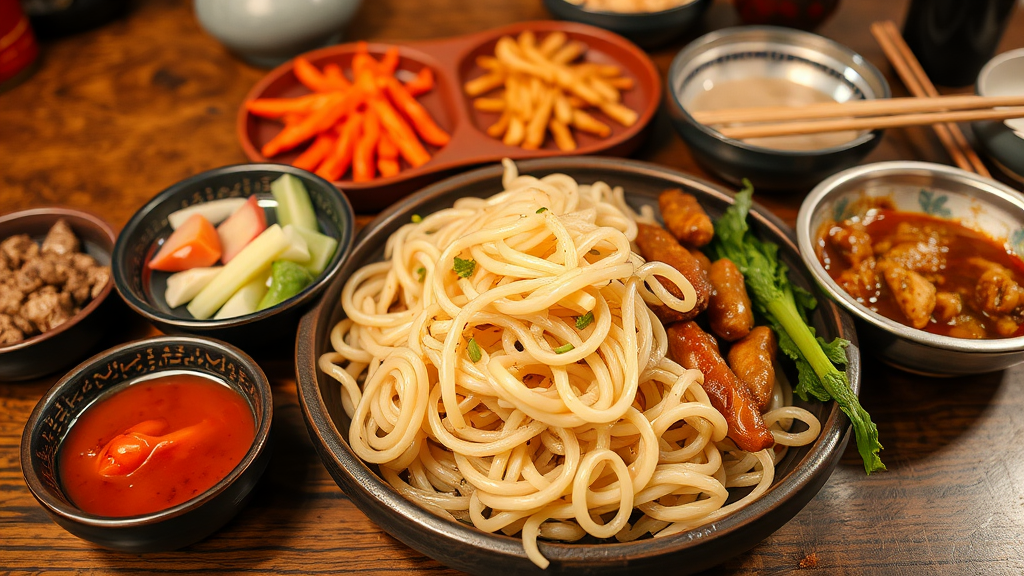
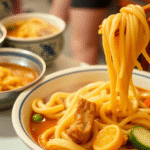

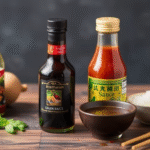

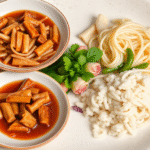
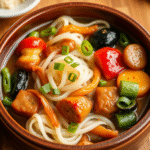
Leave a Reply